|
Monday, April 25, 2011
Progress Notes
A few weeks ago Debbie Simmons Leonard of Eldon called me and said she had discovered some old road signs which were half buried in the ground behind the old Max Allen’s Reptile Gardens building on Highway 54 just west of the 54/52 intersection. She called Max Allen Nickerson PhD, who now is a Professor and Curator at the University of Florida in the department of Herpetology, to inquire as to whether we could rehabilitate the signs and put them on display at the museum. Max very kindly gave us permission to dig up the signs and remove them.
Here are some photos we took at the place where Debbie found the signs (photos 01 and 02):
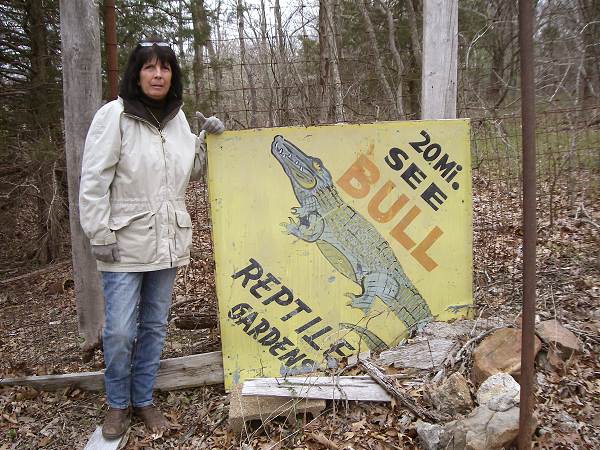
01 Debbie Simmons Leonard with Sign
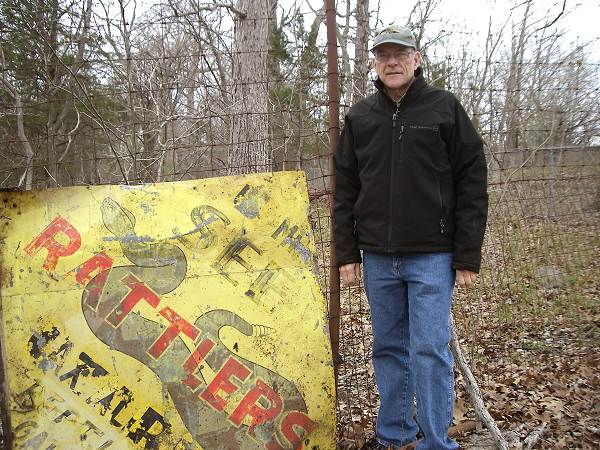
02 Joe Pryor with Sign
After extracting the signs I measured them and found they were too large for any available space we now have in the museum; however, Debbie is going to keep them in storage now for display later.
Many people here still remember the old Reptile Gardens and Max Allen Nickerson. He was interested in snakes and other creatures of the forest from early childhood. Here is photo of Max published by Dwight Weaver in his book, “Lake of the Ozarks Early Years” (photo 03):
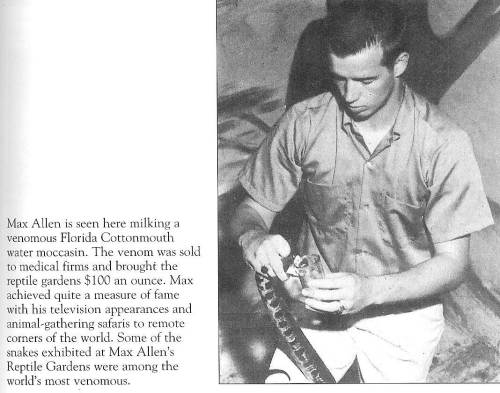
03 Max Allen Nickerson
Click image for larger view
In the same book Dwight published an old photo of the Max Allen’s Reptile Garden building (photo 04).
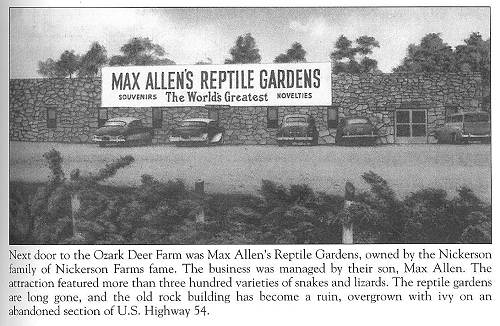
04 Max Allen's Reptile Gardens - Dwight Weaver
Click image for larger view
I found a website from which I copied some postcard pictures of the Reptile garden (photos 05, 06 and 07):
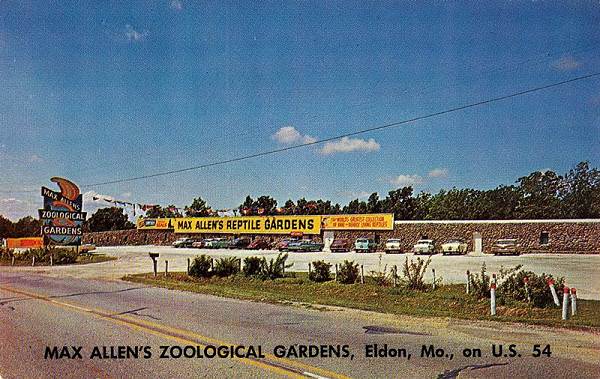
05 Max Allen's Reptile Garden
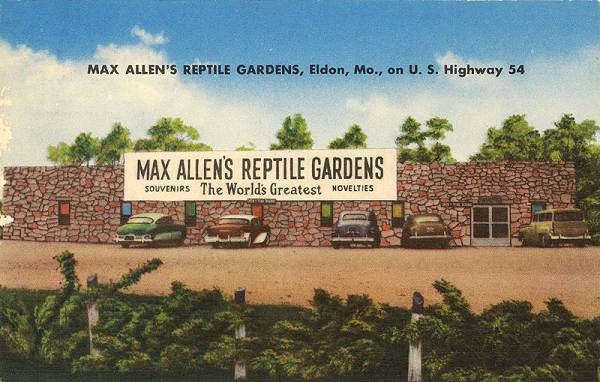
06 Max Allen's Reptile Gardens
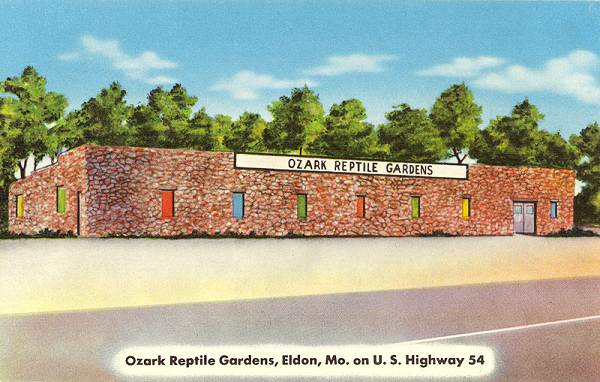
07 Max Allen's Reptile Gardens
Not long ago, I took some photos which reveal what is left of the old Reptile Garden buildings (photos 08, 09 and 10):
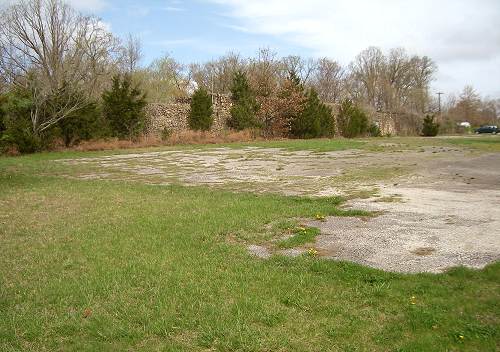
08 Old Reptile Gardens
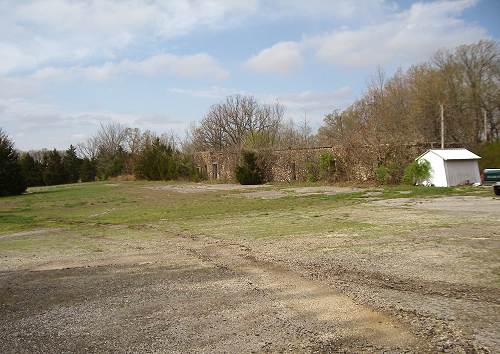
09 Old Reptile Gardens
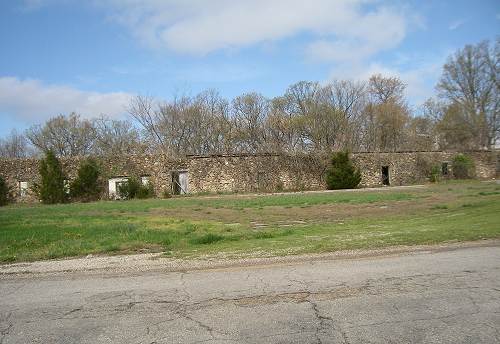
10 Old Reptile Gardens
Dwight Weaver has written a short history of the Max Allen Reptile Gardens:
REMEMBERING THE OLD HIGHWAY TO BAGNELL DAM (Part 4)
By Dwight Weaver
The narrative for Part Three of this series explored the history of Stuckey’s Pecan Shoppe and Nickerson Farms Restaurant, which once sat along old Highway 54 (now an abandoned segment of highway known as Midway Road) a short distance south of the junction of Highways 54-52 in the Eldon area.
In Part Four, we simply step next door to visit the former MAX ALLEN’S ZOOLOGICAL GARDENS, a roadside attraction that was at first typical of the small privately-owned roadside zoos so popular with vacationers in the Ozarks in the 1950s, 60s and 70s. All that exists there today are the rock ruins of a long, narrow, one-story roofless building with vacant window openings staring out at people passing by on Midway Road like empty eye-sockets.
Ivan James I. J. Nickerson, the owner and developer of the Nickerson Farms restaurant chain, opened Max Allen’s Zoological Gardens in 1951. The Nickerson family sold appliances and had businesses in Albany, Rock Port, Mound City and St. Joseph, Missouri, before moving to Eldon. They named their animal attraction for their son Max Allen who, from early childhood, had a strong interest in animals, reptiles in particular. By the time Max graduated from high school he was so dedicated to the zoological gardens and herpetology that he began running and moderating the garden’s first television programs on a local scale. Three years later he organized and led his first collecting trip outside the United States to obtain live specimens for the gardens. The field trip went as far as Guatemala in Central America. See the 1968 photo of the author’s daughter, Karen, at age eight, sitting on the back of the garden’s giant turtle (photo 11):
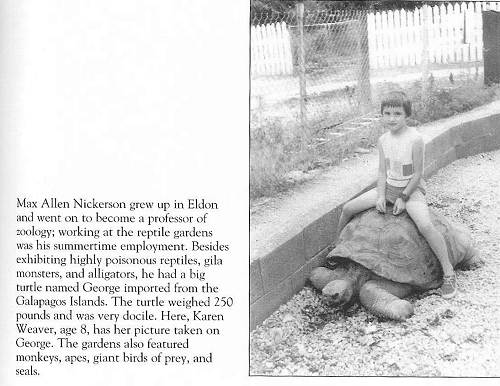
11 Karen Weaver
Click image for larger view
With Max at the helm, the zoological gardens was transformed from a run-of-the-mill roadside attraction into one of the most respected zoological parks in the world featuring live reptiles, amphibians, mammals and birds. Max also began working towards academic degrees in the field of zoology. He obtained his B.A. degree from Central College of Fayette, Missouri, and his Ph.D in Zoology from Arizona State University, Tempe, Arizona.
All of this was good for the Nickerson family roadside attraction south of Eldon. Of course with Max often away on field trips to obtain new animals and to expand his education and contacts, he had to maintain a staff of six to eight people (many of them college trained) back home to keep the zoological gardens up and running. His mother Ruby Maye Nickerson was closely associated with the management of the gardens.
A visitor to the zoological gardens could see exotic live snakes like reticulated pythons, deadly cobras and mambas as well as common species from Missouri and the Ozarks such as copperheads and rattlesnakes. Sometimes Max would demonstrate the milking of snakes for their venom. The venom could be sold for use in medical research and the creation of anti-venom. The value of this activity would be realized when one of his employees, A. E. (Ed) McDaniel, was bitten by a black mamba (Dendroaspis Polylepis) one of the worlds most deadly snakes. In Max’s own words: I had just completed my German language exam requirement for my Ph.D at Arizona State University, Tempe, when I got the call about Ed’s bite. I provided information on which anti-venom was needed and had him taken to the hospital. I then called the American Association of Zoological Parks and Aquaria (AAZPA) anti-venom officer, Dr. Herndon Dowling at the Bronx Zoo, and started the process of getting anti-venom coming in from there and the Oklahoma City Zoo. We did have one vial of polyvalent mamba anti-venom at Max Allens, but it would require many 10 cc vials to counteract the bite of a large mamba. The anti-venom from Oklahoma arrived first on a jet fighter which arrived at the Jefferson City airport and was transferred to the hospital at Tuscumbia by the Missouri Highway Patrol. Ed survived the bite and perhaps didn’t receive much venom from the bite or our quick action reduced the venoms effectiveness.
From the author’s personal communication with Dr. Max Allen Nickerson in 2004.
Not all of Max’s field trips were far from home; many were taken in Missouri. One of his favorite haunts was the wetlands and swamps of southeast Missouri where he and his students could find highly venomous cottonmouth snakes. And yes, he sometimes got bitten. One such bite cost him the first two knuckles on his right index finger.
It was field trips in the Ozarks that introduced Max to the endangered Ozark Hellbender, an ancient species of giant salamander. Once plentiful in Ozark streams, they are scarce today. Dr. Nickerson has studied the Hellbender for more than 30 years and is one of the world’s leading experts on the animal. He still prowls Ozark streams with his students in an effort to better understand and protect this fascinating creature.
Dr. Max Allen Nickerson’s accomplishments as a professional zoologist are extensive and impressive but the list is too long to cite here. He currently lives in Florida and is associated with the University of Florida at Gainesville.
Max Allen’s Zoological Gardens thrived for several decades. When U.S. Highway 54 was upgraded to a divided highway and bypassed their business location entrance, Max built a new building along Highway 52 at the northeast corner of the Highway 54-52 overpass and continued to operate for several years. That building is now being used by Mid-Mo Liquidators.
The story Dwight relates about Ed McDaniel’s snake bite is well remembered by all of us who were around at the time. It even made the news in the St. Louis Globe Democrat:
Fast Work Saves Man Bitten By Deadly Mamba Snake
Serum Flown In
Associated Press
In St. Louis Globe Democrat
(exact date not known, sometime in 1960’s)
Tuscumbia Mo.
Snakes have intrigued Ed McDaniel much of his life. He hunts them, keeps some at his home and works at a snake farm. But in a flash of carelessness Wednesday, he was bitten by a 6 foot Black Mamba that drop for drop has the deadliest venom of all.
Mr. McDaniel will live, his doctor says, because there was some serum on hand at the snake farm. Because it took only 10 minutes to get him to the hospital nine miles away; because experts all over the country gave advice; and because of an emergency flight of serum from Texas to this Ozarks hill community.
Snake Got Riled
“The snake was coiled around an electric plug in the case,” said Dorothy McDaniel, his wife. “Ed tried to get it to move, but snakes are unpredictable, sometimes they will draw back, but this time it got riled.”
The snake whipped forward and its fangs dug through the skin on the back of the middle finger like twin hypodermic needles.
“It got me,” Mr. McDaniel yelled to a co worker, J.J. Vaughan.
Mr. Vaughan took out a knife and cut off some of the flesh around the bite. Together they went into the office of the place, the Max Allen Zoological Gardens, and injected a general serum. The serum had been brought to the snake farm five weeks earlier from the St. Louis Zoo.
“We flew to that hospital, Humphreys’ Hospital in Tuscumbia” said Glen Wineinger, an employee of Nickerson Farms, a gift shop next door. “Ed kept telling us to watch his face to see if we noticed anything different, but outside of his looking pale, there wasn’t much change.”
According to Dr. Marshall Humphreys, owner of Humphreys’ Hospital and Clinic in Tuscumbia, the symptoms can be delayed and can cause damage and paralysis of muscles in the heart and lungs. “The effects show up anywhere from four or five hours to 16 or 20 hours.”
The St. Louis Zoo was contacted. Its card file showed Black Mamba serum in Chicago and Fort Worth, Texas. The zoo also asked experts on the venom in New York and Los Angeles talked to Dr. Humphreys by telephone.
An Air Force T23 jet plane from Carswell Air Force Base, piloted by Lt. Col. Don Scherrer, flew the serum from the Fort Worth Zoo to Jefferson City, and a Missouri Highway Patrol car took it the last 30 miles. By 8 p.m., about four hours after the bite, Mr. McDaniel received the life saving fluid intravenously.
Has New Thoughts
“He had some breathing trouble all night,” said Mrs. McDaniel, who stayed with her husband during the night, “But other than that he had few symptoms, some tightness in the muscles of his jaw and tongue was all.”
Thursday morning, Mr. McDaniel was a little groggy, but doing well.
“You couldn’t ask for any better care, said Mrs. Opal Schupp, a nurse. “This kind of bite was a little unusual for us. We treated some cases last year, but they were copperheads…the type you find around here.”
Mr. McDaniel also had some new thought about his love for snakes.
“He’s undecided now on whether to go back to work for Allen’s, said Mrs. McDaniel. “He said during the night he thought he’d quit, but later decided he’d go back, because he really likes the work…but he said he’ll be a little more cautious. After all, if he’d gotten into a car accident he wouldn’t quit driving.”
“I guess you might say he was bitten because he is a perfectionist. He’s already cleaned that cage with a long brush. He was told that the snake was acting a little skittish. But it isn’t good for a snake to wind around something and just stay there…they don’t eat well that way.”
“He’s caught snakes for 20 years but he’s never been scared. Now, I guess he’ll have a healthy fear of them.”
Having been raised in Tuscumbia I can attest to the belief that Dr. Marshall Humphreys was one of the best doctors I ever knew. That fact, combined with the expertise of Max Allen Nickerson who not only had serum on hand but knew where and how to get more and get it quickly probably saved Ed McDaniel’s life.
My email conversations with Max were so interesting regarding his work in herpetology here as well as in Florida that I thought some readers would be interested in knowing more about him. Max is a professor at the University of Florida where he is Curator of Herpetology. You can read about Max at the website of the Department of Herpetology.
But you may never meet an academician who has more research published than Max. Just take time to peruse this extremely impressive “Vitae” (photo 15):
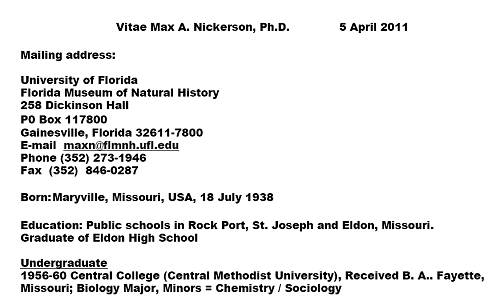
15 Max Allen Nickerson Vitae
Click image to read entire document in PDF format
Max was very kind to take the time to send us a copy of a booklet he published early on to help visitors know more about the profession of zoology. The name of the booklet is Max Allen’s Zoo World. You can read here all about the topics of species collecting, shipping, captivity, diet, disease prevention and conservation (photo 16):
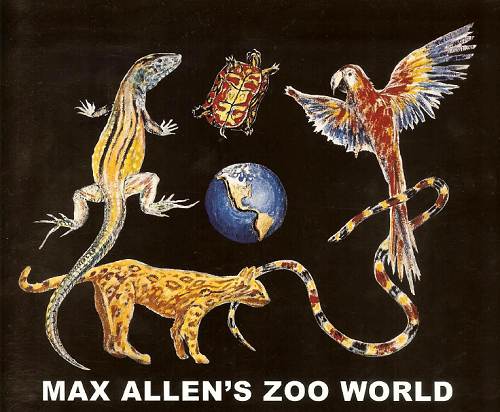
16 Max Allen's Zoo World Book
Click image to read entire book in PDF format
Dwight Weaver also has written the story of Max’s father, I.J. Nickerson, originator of Nickerson Farms:
Where Nickerson Farms Started
By Dwight Weaver
This narrative begins on Twiggy Road (formerly part of old Highway 54) near the Lake Ozark Speedway and traveled south to the junction of Midway Road and Highway 52. Silver Dollar Restaurant, a Phillips 66 Truck Stop and Heritage Inn and Suites are located here today, but in the 1930s it was the location for Gay’s Tavern, William Cahill’s Model gas station and Musser’s Ozark Tavern. From the 1950s to the 1990s, it was the location of El Rancho of the Ozarks (photo 17).
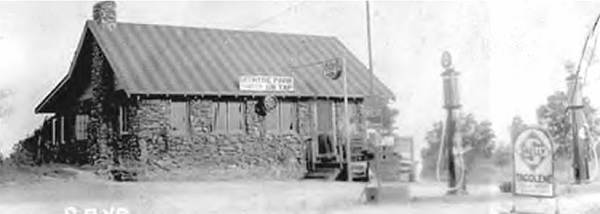
17 Gay's Service Station - Weaver
If we journey further south along Midway Road we go by an electrical substation on the right, then around a curve in the road. There is an overgrown field to the right, which was the location of an oak sawmill operation in the 1970s and early 1980s. On the left today is Handy Jon. The office building occupied by Handy Jon housed a café in the late 1970s and early 1980s. Just a bit further, on the right is the former location of two very prominent attractions in the 1950s, 60s and 70s – Stuckey’s Pecan Shoppe and Nickerson Farms restaurant. All that marks the location today is a concrete slab. Toward the back of the lot is a mobile home.
Travelers of the 1950s could not miss seeing these two businesses, first because the high-peaked roof of the large Nickerson Farms restaurant building was a brilliant red, and the Stuckey’s building sat close to the old highway. Many travelers were familiar with the Stuckey’s brand name because it was a chain known best east of the Mississippi River. The Stuckey’s business here was the first one built west of the Mississippi River and was established in 1957 by I. J. Nickerson of Columbia, Missouri.
Stuckey’s carried a wide variety of candy, sold many varieties of honey, and had a colony of bees with the hive built into the wall of the building. The author can remember once standing before the clear glass window that separated the active bees from the interior to watch the bees as they made their honeycomb and raised their young. It was a fascinating and educational exhibit for which there was no charge.
The building that housed the restaurant was quite large and built in the Tudor style of architecture. It had a steeply pitched roof with gable ends and had half-timber cross gables decorating the exterior white walls of the restaurant. The restaurant could seat up to 100 guests and the author can remember eating there at various times. They served excellent meals ranging from hamburgers to steaks.
The Nickerson Farms headquarters was located in Eldon for a time. For a look at the distinctive architecture that characterized the Nickerson Farms restaurants, one can drive down Oak Street in Eldon. Their former headquarters building is along Oak Street across from the fire station. The former headquarters building also displays another feature characteristic of Tudor style buildings – tall, narrow, multi-paned, paired windows.
The Nickerson’s stated their goal in their advertising. It was “to have the cleanest, friendliest, most courteous stops on the nation’s highways, and to sell the finest products available at the best prices possible and to give fast efficient service to all of our customers.”
The Nickerson’s were in the right place at the right time to begin their ambitious plan for building a chain of Nickerson Farm restaurants across the nation because the Federal-Aid Highway Act of 1956 authorized the construction of 41,000 miles of Interstate highways. Interestingly enough, Missouri was the first state in the nation to begin Interstate system construction. Within a few years the Nickerson’s had their restaurants in 17 states. You could see them from miles away because of their bright red roofs and they were generally located as close as possible to a major off-ramp.
Nickerson Farm restaurants were not franchise operations. They were wholly owned by the Nickerson’s who hired managers to run each restaurant. The author can remember being in their headquarters building in Eldon in the 1960s and marveling at the rows of desks, each occupied by a lady with a busy telephone responsible for a particular group of restaurants at some far away location.
But back home at Eldon, where they built their very first restaurant, which just happened to be on the road to Bagnell Dam, matters weren’t always smooth sailing. It is said they had differences of opinion with W. S. Stuckey of the Stuckey chain over whether to serve complete restaurant meals, as the Nickerson’s wanted to do, or just fast food. The first ads for Stuckey’s called it a “candy shoppe” but then it became a “pecan shoppe.” Not long afterwards the Stuckey’s building was remodeled to house the restaurant. A peaked-roofed pyramid-style canopy with a brilliant red roof was built to protect customers from the weather while filling their gas tank in front of the restaurant.
Nickerson Farms restaurant remained in business to about the year 1980.
Sometime after the closure of the Nickerson Farms restaurant the Nickerson’s moved to Arizona.
Here is the obituary of I.J. Nickerson:
Birth:
Apr. 29, 1908
Chadron
Dawes County
Nebraska, USA
Death:
Nov. 15, 1998
Green Valley
Pima County
Arizona, USA
Businessman. Founded the chain of Nickerson Farms restaurants. Ivan James "I.J." Nickerson and his twin sister, Imo Jean, grew up in Missouri. He attended NW Missouri State College. He eventually became a franchisee of Stuckey's Pecan Shoppes in Eldon, Missouri. Stuckey's preference of a fast food service counter in its stores, in favor of a sit-down full service restaurant, led Nickerson to end his franchise and start Nickerson Farms. His stores were known for their barn style buildings with bright red roofs. Each store offered a full service restaurant, gas pumps, and gift shop featuring on-site beehives. Honey was collected from the hives and sold in the stores. Like Stuckey's, Nickerson Farms stores had a specialty product. Instead of pecans, Nickerson chose to specialize in honey. The idea was a success and as many as 60 stores were eventually built beside interstates across the country. All stores were company-owned in order to prevent franchisees from breaking off and starting competitive businesses. The chain was sold to investors after a few years but struggled to survive due to increased competition and poor management. This led to the chain filing for bankruptcy and all stores were closed in the early to mid 1980's. I.J. Nickerson's grave is located at Green Valley Mortuary and Memorial Gardens, which is in Green Valley, AZ. His ashes are interred with those of his wife, Ruby M. Nickerson (September 24, 1912-September 3, 2005).
Burial:
Green Valley Mortuary and Memorial Gardens
Green Valley
Pima County
Arizona, USA
Many tourist related businesses have come and gone through the years on the way from Eldon to Lake Ozark along old Highway 54. Especially is this true along the “strip” just west of Bagnell Dam. Dwight Weaver has covered this area very well in his last book Historic Bagnell Dam Boulevard.; However, some of the businesses have had “staying power.” One of these is “Dogpatch.” This tourist attraction was opened in 1947 by Walter Tietmeyer and is still very popular now under the ownership of Mike Page. In 2007 Mike published a short booklet about his business with quite a few photos. A copy of the book was given me by Clark Sandfort which you can read here (photo 23):
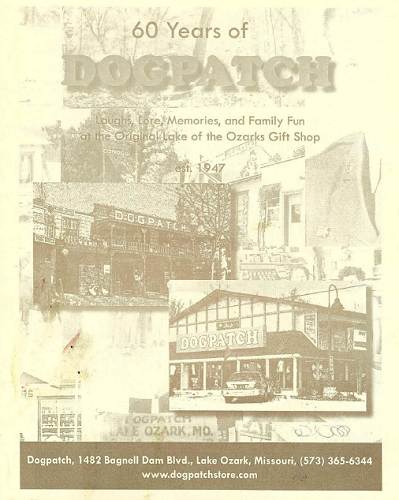
23 Dogpatch Book
Click image to read entire book in PDF format
Two other tourist attractions on the Lake Ozark “strip” have been around a long time at least from the early sixties. These are the Rebel Arcade on the west end of the “Strip” across from the Christian Church, close to the Osage Elementary school; and the Bumper Car/Skee ball attraction closer to the Dam on the same side of the road. Here are three older photos of these attractions taken by Dwight Weaver (photos 24, 25 and 26).
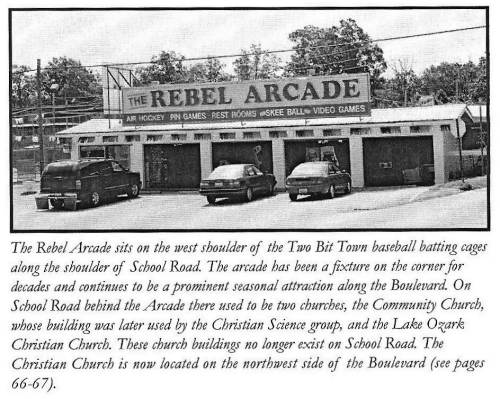
24 Rebel Arcade - Weaver
Click image for larger view
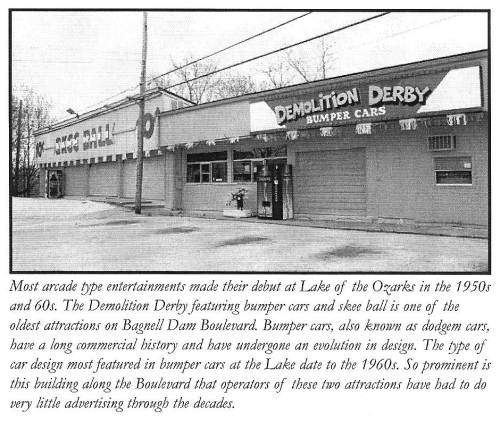
25 Bumper Cars and Skee Ball - Weaver
Click image for larger view
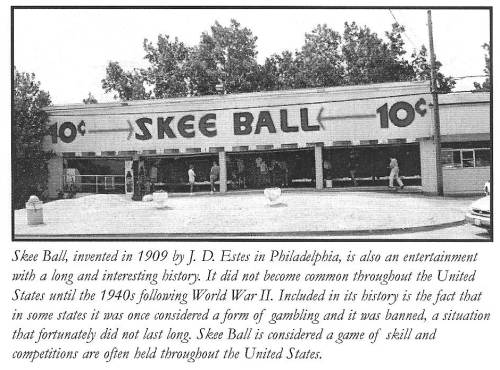
26 Skee Ball - Weaver
Click image for larger view
And here are two recent photos of the same businesses still in operation after all these years (photos 27 and 28):
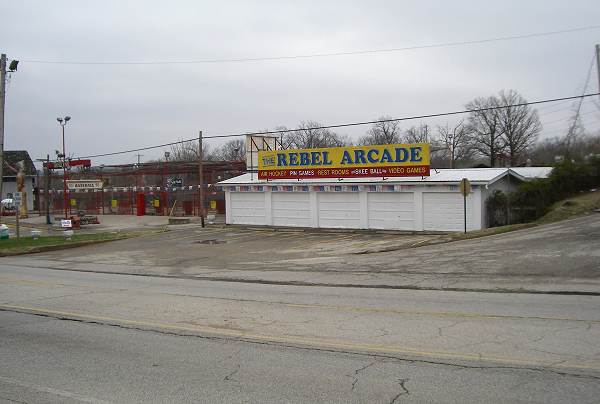
27 Rebel Arcade
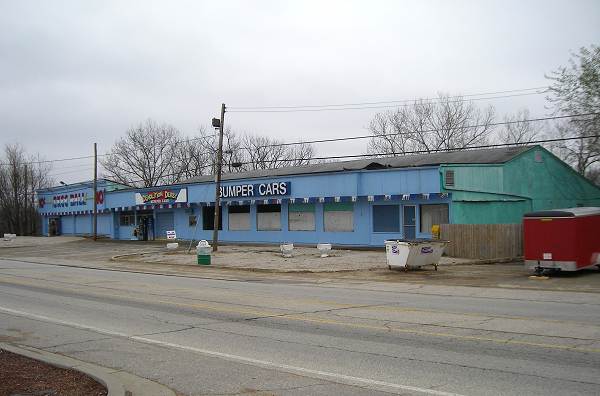
28 Bumper Cars and Skee Ball
These two businesses were started by Clark Sandfort in the early sixties. Clark later sold the businesses ten years later in the early 1970’s before he moved to California (photo 29).
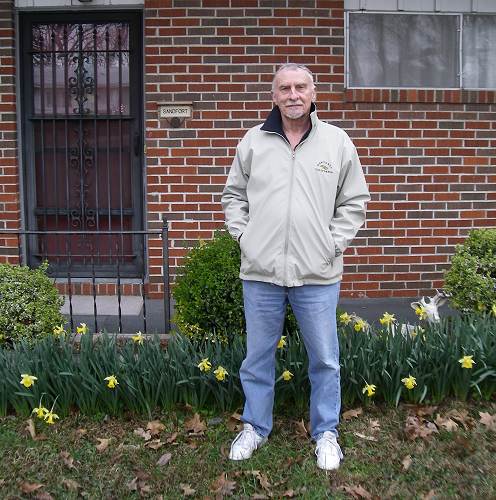
29 Clark Sandfort
Clark told me that operation of these tourist attractions was very easy; all he did was sell tickets or tokens for the games or the bumper cars. He had neither shelves of souvenirs to fill or organize everyday, nor messy ice cream or food to serve, and no tables to clean.
Another story I have to tell also was inspired by an old sign. A couple of years ago a school classmate of mine, Cleta Wood, called me to tell me she had found an old metal sign in a junk yard in which I might be interested. The sign was rusted, bent and torn but I was able to recognize the name “Mace” (photos 30 and 31).
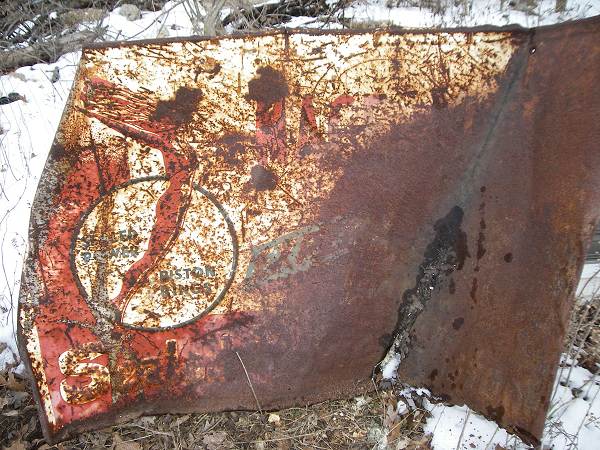
30 Mace Sign
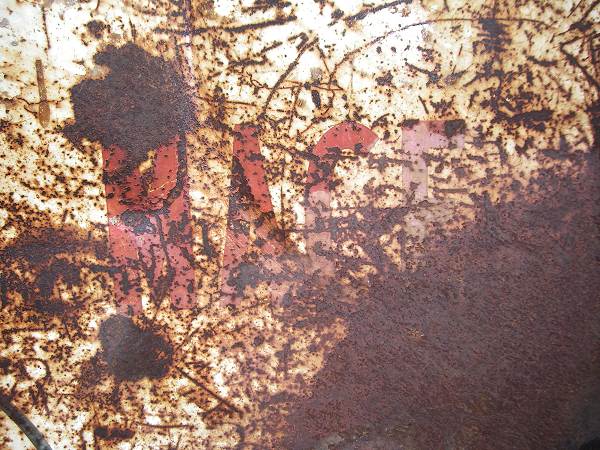
31 Mace Sign
Some other lettering on the sign indicated it had something to do with a service station, which reminded me that Lucian Mace and Tolliver Lawson had started the first car dealership in Tuscumbia in the 1940’s (photos 32 and 33).
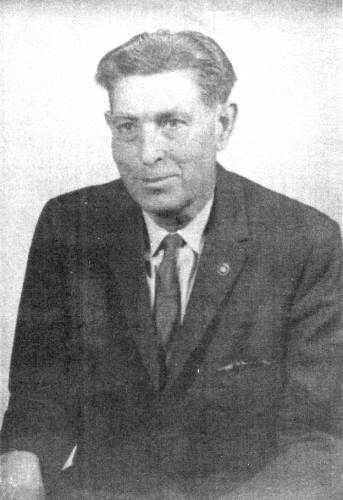
32 Lucian Mace - 1960's
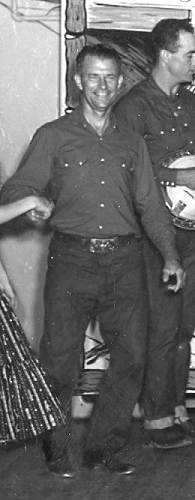
33 Tolliver Lawson
The business, which sold Chrysler products, was located in the old Frank Thompson garage just north of Sweeney’s café. I don’t have a frontal photo of that building but I do have one of a partial side view of it, which reveals the rear of the building. In the next photo you can see the partial view of the building behind and to the left of the stone Woodman Hall/Bear/Sweeney store (photo 34).
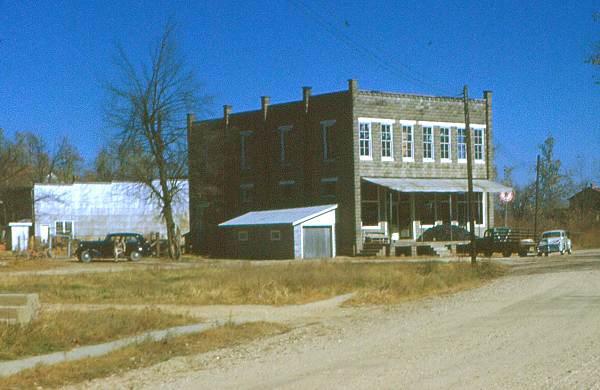
34 Woodmen Fellow Hall - Sweeney - Bear Building
Here is a photo of what is left of the building, which is only its foundation (photo 35):
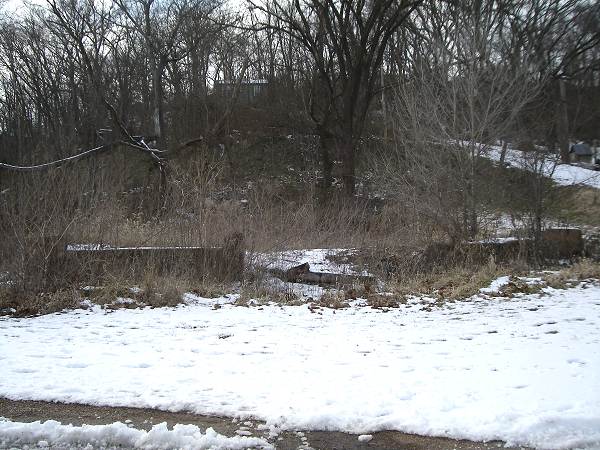
35 Thompson Mace Garage
A couple of years ago I called Sue Mace, daughter of Lucian, and here is what she remembered about the history of this dealership:
I do remember Tolliver Lawson coming to our house and I seemed to know this involved a different kind of serious business. From that meeting was the beginning of the Lawson-Mace Motor Company. They started selling Chrysler and Plymouth cars around 1946. This was the post-war era and another cultural shift. People had been through the depression, they had rationing during the war, but now times were good and there was more discretionary income and the demand for automobiles out stripped the supply. Many of the dealers sold their cars to the highest bidder, but Tolliver and Dad prided themselves on selling to the next person in the community that was on the list and selling the car at a fair price. The garage was located “under the hill” down by Sweeney’s Tavern. Eventually Chrysler corp. thought their dealers should have a better show room and around the early 50’s Dad bought the garage and service station at the junction of 17 and 52. He bought out Tolliver at that time and built a show room that connected the garage and service station. We lived in the living quarters of that building for a year or two and even though we had electricity, phone and indoor plumbing, it was not worth the lack of privacy so we moved back to the farm property that was about a mile east of town. My Uncle Hig Atkison wired that house for electricity but we never did have a phone or indoor plumbing there.
One of the things I remember about the dealership was the day Tolliver bought a brand new yellow Chrysler convertible which was one of the most appealingly beautiful and exciting cars I ever remember seeing, even now. My father bought one of Tolliver and Lucian’s Plymouths (photo 37).
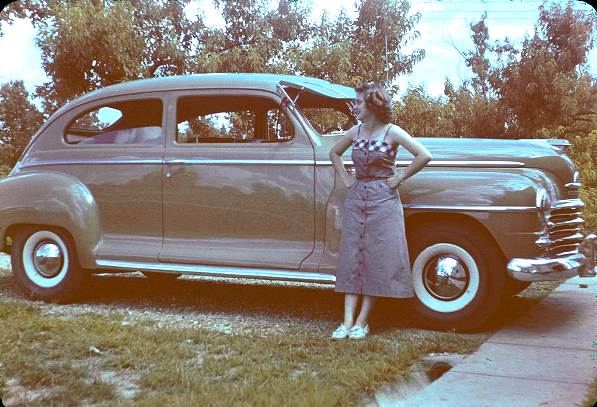
37 Late Forties Plymouth - Bonnie Bear Tyler
As noted above by Sue, Lucian and Tolliver left the Thompson Garage in the early 1950’s and moved their dealership to the service station at the intersection of Highways 52 and 17. Soon afterward, Lucian bought Tolliver’s share of the business, which ended some time in the mid 1950’s when Sid Reed bought the service station but did not continue the Chrysler dealership.
A while back I took a photo of the Horseshoe Bend road looking west and put it on the website. Recently, I found a Joe Orr painting of the same scene hanging on the wall in Baxter’s Restaurant at Lake Ozark. The photo I took was in winter but Joe’s painting is more colorful depicting a summer scene. You can compare both photos here (photos 38 and 39):
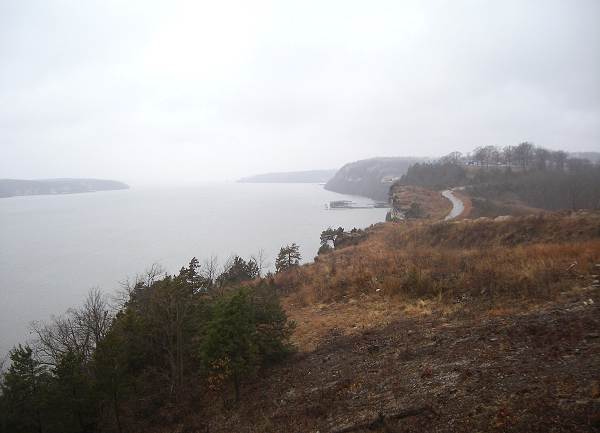
38 Old Horseshoe Bend Road
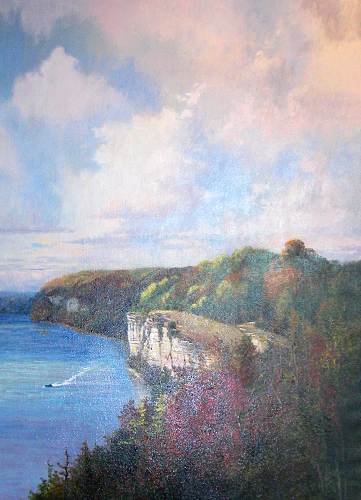
39 Horseshoe Bend painting by Joe Orr
That’s all for this week.
 Joe Pryor
Previous article links are in a dropdown menu at the top of all of the pages.
|

